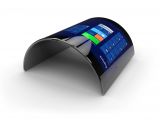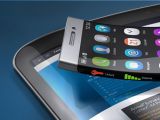Apple’s newest inventions can easily be filed under science fiction, including this latest application titled "Electronic Devices With Flexible Displays." If so far flexible meant bendable, now Apple is flexing even more brain power to achieve a display that lets you run your fingers through it.
A continuation of U.S. patent application No. 13/171,295, filed Jun. 28, 2011, this new invention calls for an electronic device that sports a flexible screen as well as flexible innards positioned under the display in such a way that they can sense touch together with the screen, and even supply feedback to the user in the same manner: by bulging outwards when necessary.
“Permanently or temporarily deformed”
According to the abstract of the filing, “Electronic devices may be provided that contain flexible displays and internal components. An internal component may be positioned under the flexible display. The internal component may be an output device such as a speaker that transmits sound through the flexible display or an actuator that deforms the display in a way that is sensed by a user.”
To achieve such a device, Apple would undoubtedly need a viscous material that not only resists wear and tear, but also can conduct electricity and allows light to pass through.
Much of the input would be made through touch, but Apple imagines that such a device could at least take some commands in the form of sound waves generated by the press (i.e. when the display makes physical contact with other components).
“The internal component may also be a microphone or pressure sensor that receives sound or pressure information through the flexible display. Structural components may be used to permanently or temporarily deform the flexible display to provide tactile feedback to a user of the device.”
iPhone 10?
Needless to point out, the company files these patents just to be safe. The general idea is that you never know when a bunch of MIT students bang those neurons together and come up with a way to make a device entirely of graphene or any other exotic material that springs to mind when science is on the menu.
Apple would undoubtedly have to wait at least five years or so before it can even begin to test such an application, let alone put it to practical use, let alone take it into mass production. But the prospect is tantalizing to say the least.
Currently, our screens feel rigid and dead, even though there’s action underneath them. Haptic feedback is a good first step towards the realization of devices that “answer back,” yet Apple has been reluctant to use the technology so far.

 14 DAY TRIAL //
14 DAY TRIAL // 



